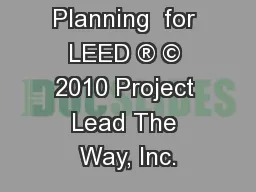

Civil Engineering and Architecture Leadership in Energy and Environmental Design LEED and its related logo is a trademark owned by the US Green Building Council and is used by permission ID: 727202
Download Presentation The PPT/PDF document "Planning for LEED ® © 2010 Project Le..." is the property of its rightful owner. Permission is granted to download and print the materials on this web site for personal, non-commercial use only, and to display it on your personal computer provided you do not modify the materials and that you retain all copyright notices contained in the materials. By downloading content from our website, you accept the terms of this agreement.
Slide1
Planning for LEED®
© 2010 Project Lead The Way, Inc.
Civil Engineering and Architecture
Leadership in Energy and Environmental Design
LEED
®
and its related logo is a trademark owned by the U.S. Green Building Council
®
and is used by permission Slide2
Planning for LEEDLEED DefinedGreen BuildingEnvironmental Impact of BuildingsWhy LEED certify?LEED for Building Design and ConstructionLEED for Homes Credit CategoriesFour Levels of LEED CertificationHome Size Adjustment
Cost of LEEDCertification for Architects and DesignersSlide3
LEED Defined Leadership in Energy and Environmental D
esign
The LEED Green Building Program—An independent certification program developed by the U.S. Green Building Council that provides rating systems for the design, construction, and ongoing operation and maintenance of high performance green buildings Slide4
Green BuildingPlanning, design, construction, operations, and end-of-life recycling of structuresSolutions that represent a healthy and dynamic balance between environmental, social, and economic benefitsTriple Bottom Line—a long term view for assessing potential effects and best practices for:PeoplePlanetProfit
U.S. Green Building CouncilSlide5
The Environmental Impact of BuildingsIn the United States buildings account for:
14% of potable water consumption30% of waste output40% of raw material use38% of carbon dioxide emissions24% to 50% of energy use72% of electricity consumption
Source: Environmental Protection Agency (2009). Buildings and their Impact on the Environment: A Statistical Summary
Slide6
Why LEED Certify?Reduce the building’s carbon footprintImprove productivity of building occupantsReduce operating and maintenance costsReceive recognition for your commitment to environmental issues in your community, your organization, and industryReceive third-party validation of achievementQualify for federal, state, and local government financial initiativesReceive positive marketing exposureSlide7
LEED for Building Design and ConstructionNew constructionCore and shellData CentersHospitalitySchools
RetailHealthcareWarehouses and Distribution CentersHomesMultifamily Mid-riseSlide8
LEED for Homes Credit CategoriesIP Innovative ProcessLT Location and TransportationSS Sustainable SitesWE Water EfficiencyEA Energy and AtmosphereMR Materials and ResourcesEQ Indoor Environmental QualityIN Innovation RP Regional PrioritySlide9
IP Innovative Process Effectively implementing an integrated design process, with input from multiple stakeholders, can keep cost down and ensure appropriate integration of green building techniquesSlide10
LT Location and Transportation Encourages the placement of homes in socially and environmentally responsible ways in relation to the larger community
©iStockphoto.com
Courtesy Isle of Palms, SC Recreation DepartmentSlide11
SS Sustainable Site The site is designed to minimize the project’s impact on the environment and takes into consideration local and regional ecosystems, environmental preservation, and long-term management needsSlide12
WE Water Efficiency Careful attention is given to promoting water conservation both indoors and outdoorsSlide13
EA Energy and Atmosphere Promotion of on-site renewable energy resources and maximization of energy performance help protect the environment and human health.Slide14
MR Materials and Resources Efficient use of environmentally preferable materials and minimizing the amount of waste during construction reduces negative impacts on the environment.Slide15
EQ Indoor Environmental Quality Reducing the creation of and exposure to pollutants can greatly improve the indoor air qualitySlide16
IN Innovation Points can be earned for design and construction techniques that use innovative green strategies, provide exemplary performance levels, or incorporate regional best practicesSlide17
RP Regional Priority Allows LEED project teams to address critical environmental issues in the specific project localeSlide18
Four Levels of LEED for Homes CertificationLEED CertifiedLEED SilverLEED GoldLEED PlatinumSlide19
Home SizeLarger homes consume more resources and result in more greenhouse gasesLEED Home Size Adjustment allows for a reduction in credit point requirements for smaller homesSlide20
Home Size AdjustmentCompared to ENERGY STAR reference home +1 point for every 4% decrease in conditioned floor space –1 point for every 4% increase in conditioned floor spaceSlide21
Cost of LEED Green buildings can return cost savings depending on the design strategies for the structure. Some green designs may cost more up front, but they can save money due to lower operating costs during the life of the building.Slide22
Certification for Architects and Designers Certification can be obtained by design professionals through classes, seminars, and testing. Once training is complete, designers can become a LEED AP® (Accredited Professional). Slide23
ReferencesThe Royal Academy of Engineering (2005). Engineering for sustainable development: guiding principles. Royal Academy of Engineering: London.U.S. Green Building Council. Getting started with LEED Homes. Retrieved from http://www.usgbc.org/articles/getting-started-homes. Slide24
Image ResourcesIsle of Palms Recreation Department. Isle of Palms, SC 29451Istockphoto. Retrieved March 1, 2010, from www.istockphoto.com.Microsoft, Inc. (2009). Clip art. Retrieved April 7, 2009, from http://office.microsoft.com/en-us/clipart/default.aspx